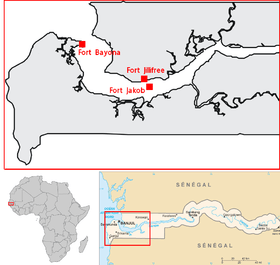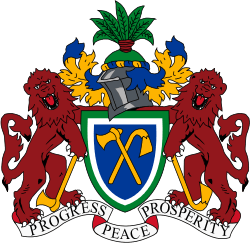Couronian colonization



Part of a series on the |
|---|
| History of the Gambia |
 |
| Chronological |
| Gambia portal |
Couronian colonization refers to the colonization efforts of the Duchy of Courland and Semigallia, a vassal of the Polish-Lithuanian Commonwealth. Small but wealthy, it took a modest part in the European domination and settlement of West Africa and the Caribbean.
History
Like Brandenburg, that had far larger German colonizing power before the formation of the German Empire, the Polish-Lithuanian fief of Courland had a European crusading, hence expansionist, past. The colonies were established under Jakob, Duke of Courland and Semigallia (German: Jakob, Herzog von Kurland und Semgallen), and were indirect colonies of the Polish-Lithuanian Commonwealth. During his reign, the duchy established trading relations with all of the major European powers. Jakob established one of the largest merchant fleets in Europe, with its main harbors in Windau (today Ventspils), and Libau (today Liepāja). His fleet made voyages to the West Indies as early as 1637 when the settlers on the ship established the first colony on Tobago. The first colony was a failure, but it was refounded in 1639.
In 1651, the Duchy gained a colony in Africa on St. Andrew's Island at the Gambia River and established the Jacob Fort there. The Duchy also took other local land including St. Mary Island (modern day Banjul) and Fort Jillifree. The Duchy's colonies exported sugar, tobacco, coffee, cotton, ginger, indigo, rum, cocoa, tortoise shells, tropical birds and their feathers. The Courlanders retained control of these lands for less than a decade and they were formally ceded to England in 1664.
The colonies were lost when neighboring nations took advantage of Courland during the Northern Wars, when Jakob was held captive by the Swedish army (1658–60). However, Tobago was returned to Courland, but the Duchy abandoned it in 1666. In 1668, a Courish ship attempted to reoccupy Fort Jacob but was driven off by the Dutch. The Courland Monument near Courland Bay commemorates the Duchy's settlements.
A final Courish attempt to establish a Caribbean colony involved a settlement near modern Toco on Trinidad.[1]
Former colonies
- St. Andrews Island or Courlander Gambia (the later British Fort James) (1651–1660, 1660–1661)
- New Courland on Tobago (1637, 1642, 1654–1659, 1680–1690)
See also
References
- ↑ Kołodziejczyk, Dariusz. Mówią wieki. "CZY RZECZPOSPOLITA MIAŁA KOLONIE W AFRYCE I AMERYCE?". (Polish)